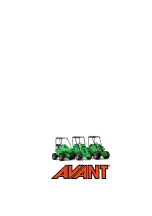
13(18)
Beware of the caving in hazard at the excavation and around it. Do not drive near the
edge of the hole or allow children to play near it.
Do not operate the backhoe at horizontally overly tilted terrains. Transport the backhoe
as low and close to the loader as possible. Drive carefully on inclined terrains.
Drive the loader so that digging is performed from front of the loader. On inclined terrains avoid excess
pulling from the sides, which can affect the stability of the loader.
Digging with the backhoe is the most efficient when the edge of the bucket is kept at an angle that allows the
edge to cut the soil the most effectively. Pull the edge of the bucket towards the loader with the left lever and
tilt the bucket by operating the right control lever at the same time. The bucket should not be pressed too
hard downwards, since this would result in lifting the front tires of the loader, and digging becomes
ineffective.
When operating with the backhoe, moderate engine revolutions are often enough. Higher revolutions will not
increase the digging force. Keeping the engine revolutions moderately low will save fuel; keep the
revolutions just high enough so that the engine will not stall.
At the first use the movements of the backhoe may be imprecise as there might be air trapped in the
hydraulic components. The hydraulic system will bleed itself, when moving all the movements to their
extreme positions.
When lifting a load from a high level, the loader could tip forward when reversing with
the loader. Do not reverse the loader while simultaneously dragging the load. Make
sure that the loader can lift and handle the load being lifted. Drive carefully on rough
terrains and keep the load as low and as close to the loader as possible.
Do not use the backhoe without the supporting bracket. The purpose of the bracket is
to lock the tilting and to make the backhoe more stable for more effective operation.
7.
Inspections, maintenance and servicing
Continuous maintenance of the backhoe includes regular cleaning and lubricating. The condition of the
hydraulic hoses and components should be monitored. Due to crushing hazard caused by the moving
components of the backhoe, all maintenance work must be done when the backhoe has been lowered down
completely, its residual pressure is released and the loader is shut down.
Ensure that the backhoe is properly supported before any maintenance work. Note that
the backhoe may move also when the loader has been shut down and watch out
pinching of fingers or hands in particular.
Check the condition of the hydraulic hoses and components when the engine has been turned off and the
pressure has been relieved. Repair all leaks immediately after detecting them; a small leak can quickly grow
into a big one. Do not use the equipment, if you have discovered a fault in the hydraulic system. Leaking
hydraulic fluid may penetrate the skin and cause serious injuries. Hydraulic fluid is also harmful to the
environment.
























